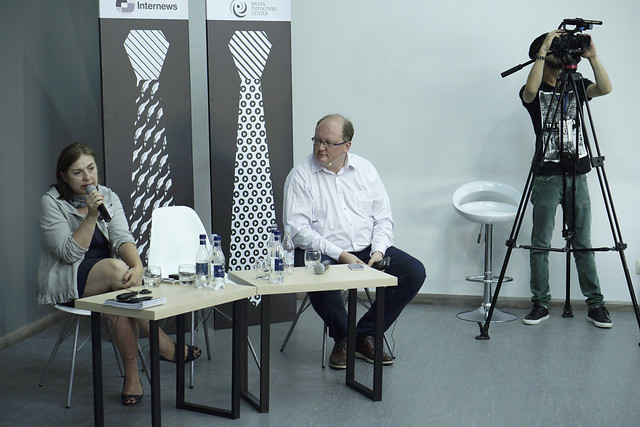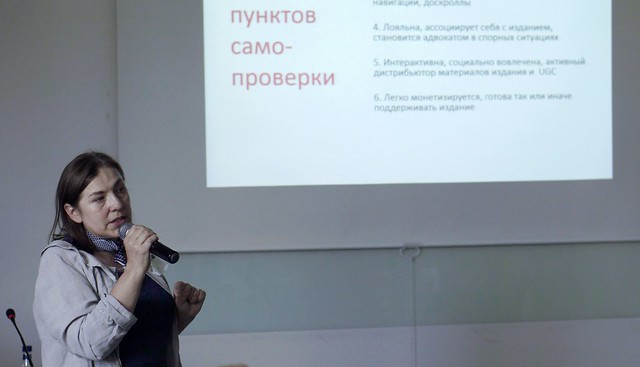Media producer, new media expert, journalist, and lecturer Natalia Loseva defines the impact of the digital environment very clearly: human beings change both psychologically and physiologically.
At the Tvapatum media conference in Yerevan, she presented the steps that will help the media to broaden its audience. Under conditions of hyper-awareness, the first step is distinguishing your audience from traffic. “Traffic is just raw material that helps to create the audience. It’s not important who reads you; what’s important is who returns,” she said.
And under these conditions, when you are fighting for users’ attention, media outlets try to avail of the opportunities afforded by social media and messaging apps, simultaneously accepting that anyone who follows and subscribes to specific media content becomes a potential agent for recruiting new audiences.
Loseva reminds us that people now don’t read media but follow the story. And where that story is doesn’t matter.
Has the philosophy of information consumption and production changed?
The physiology of information perception has changed. In fact, the changes are qualitative, topological, and physiological.
It’s obvious that people are prepared to spend much less time in one session to get information. And it’s very difficult to offer the consumer immersion, in the case of a provisional unit of information.
It’s at the physiological level that people have become multi-channeled; that is, one informational pipe is not enough for them.
And this means that modern man gets information as the whole body breathes — simultaneously with his lungs, heart, skin, and other organs.
A person doesn’t say, let me go and read the news or an article. He has the impression that he is in a river of information, and his sense of perception works approximately like so: this I need, this I don’t, this is needed only for the headline, and this is worth immersing in.
The choice is often emotional: I watched a video, let me go and watch about 10 more of the same.
Twenty to thirty years ago, news consumers had certain times in their daily schedule allocated for getting information (buying a newspaper, turning on the TV at specific times). Now it’s not like that.

The ritual has ended…
Yes, it was a particular ritual. People would get information on schedule, but now they are constantly in an informational context. It’s not even a flood [of information], but a context.
A person allows herself to respond or not to respond. If the content matches her expectation, the surface skimming turns into a deeper consumption.
And how is journalism changing? Does it also look like a river?
We work not for ourselves, but for the consumer, with whom we have to establish a connection. And of course, the main development of journalism will happen in the skills to establish contact.
We have to think about how to become noticeable in an informational river, where each one of us is one of a million players. How to be noticed? in what places? when? with what content?
I believe one of the most effective tools of journalism are the different types of subscriptions.
This way, the media, it seems, legitimizes its relationship with the consumer. It’s akin to signing a marriage contract, when both parties’ obligations are clarified. For example, we tell the consumer, subscribe to our Telegram channel and you will not only allow us to provide you news directly, but also help us to stop being [merely] a drop of water in the flood.
The media wants the consumer to let him in.
And the fight to enter the consumer’s home is media business’s main problem.

But there’s the impression that long, thought-provoking content is in greater demand in a fragmented reality.
Content that requires deep perception is premium content and is not intended for a wide audience.
If we analyze what types of media have a successful model of paid content, we’ll see that they’re mainly creators of “thinking” content.
A person subscribes because he feels the need for interesting reinterpretation. The New York Times’s paid content is not the news.
There’s no shortage of news. I compare this situation with the Olympic Games, when it’s not hard to know who ran the fastest or who jumped the highest. That’s no longer competitive news; competition will take place when the media describes, say, the athlete’s personal drama or any emotional story about victory and overcoming [defeat, obstacles].
That is to say, what is sold is not the already-known fact, but the the dramaturgy built around that fact.
Is it possible without financial support from the state or large associations to become a media that sells? In Armenia and Russia, this seems impossible. Is the problem the market not being liberal?
There are different stories. For example, just 20 people produce the Dutch De Correspondent; it has paid subscription and it’s very profitable.
I don’t believe that media outlets using an advertising model today can be self-sustainable. The money that’s needed hasn’t yet moved from offline to online. The money has to come from television to the internet and feed media outlets.
And that powerful wave thanks to which Google, Yandex, and postal services make money simply won’t work in the case of a smaller media outlet. A small media’s consumer is worth much more than the consumer who comes from search engines.
For this reason, I think that in the post-Soviet space the media can exist only when it has the support of some corporation or another.
Of course, again we return to the question of whether the media can be independent if it is politically independent but it serves business. Understandably, if it’s a large business and not a small bread-baking factory, then what the rules of the game will be must be agreed upon from the start.

The claim that every journalist is also a distributor (that is, she disseminates, promotes, and discusses her news stories), it seems, allocates a bigger space to the journalist individually than the media outlet she works for.
In a sense, yes. There was a research study done a long time ago, which, however, is very relevant still today. Studied was the transformation of the traditional journalism genre, the column, in the digital environment.
In the old media, the columnist would come, write, and leave, but in the new media, the column is an idea that promotes the art of discussion. And that is considered distribution of information.
We access Facebook and with our column (of course, professional and unbiased) we begin to converse with the audience.
And that’s a different type of art. But definitely no less important than journalism.
To converse in the digital arena, a higher level of readiness is necessary, since when you’re only published in the newspaper you’re somehow protected.
But online, people ask you direct questions; they don’t agree, sometimes also with strange versions. When participating in a debate, it’s very important that the debate’s content and aesthetics be no less interesting than the column itself.
Understandably, this requires more effort and time from the journalist, but those people with whom you’ll be discussing and arguing will see that their voices were heard. And so they will return…
On social networking sites, there’s an enormous segment of users who are unable to formulate their own opinion. In general, 7–10% of users can formulate their viewpoint and attitude on this or that event.
There is a segment of the audience that is very passive (only likes silently), while the majority are ready to find views in line with their thoughts, which are already shaped by another person.
And so a new demand for quality journalism emerges. A person thinks that if he can’t wrap his head around a topic but there’s a journalist whom he trusts, then he’s ready to share her news stories. And he does. That is, he becomes the journalist’s distributor.
Interview by Nune Hakhverdyan







